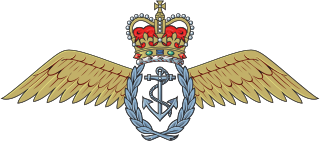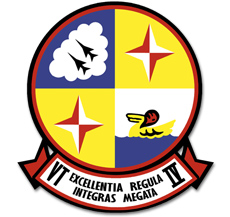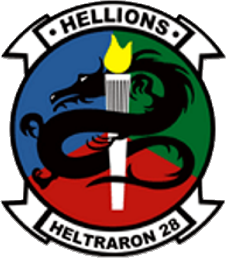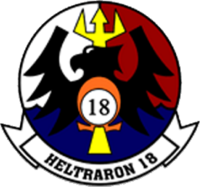
The Fleet Air Arm (FAA) is the naval aviation component of the United Kingdom's Royal Navy (RN). The FAA is one of five RN fighting arms. As of 2023 it is a primarily helicopter force, though also operating the F-35 Lightning II carrier-based stealth fighter jointly with the Royal Air Force.
A naval flight officer (NFO) is a commissioned officer in the United States Navy or United States Marine Corps who specializes in airborne weapons and sensor systems. NFOs are not pilots (naval aviators), but they may perform many "co-pilot" or "mission specialist" functions, depending on the type of aircraft. Until 1966, their duties were performed by both commissioned officer and senior enlisted naval aviation observers (NAO).

VT-4 Training Squadron 4 is a training squadron of the United States Navy. Initially established as Basic Training Group NINE (BTG-9) in the 1950s, the squadron was redesignated as Training Squadron FOUR (VT-4) on 1 May 1960 and based at Naval Air Station Pensacola, Florida.

The Bell 206 is a family of two-bladed, single- and twin-engined helicopters, manufactured by Bell Helicopter at its Mirabel, Quebec, plant. Originally developed as the Bell YOH-4 for the United States Army's Light Observation Helicopter program, it was not selected by the Army. Bell redesigned the airframe and successfully marketed the aircraft commercially as the five-place Bell 206A JetRanger. The new design was eventually selected by the Army as the OH-58 Kiowa.

Naval Air Station Whiting Field is a United States Navy base located near Milton, Florida, with some outlying fields near Navarre, Florida, in south and central Santa Rosa County, and is one of the Navy's two primary pilot training bases. NAS Whiting Field provides training for U.S. Navy, U.S. Marine Corps, Coast Guard, and Air Force student pilots, as well as those of several allied nations. NAS Whiting Field is home to Training Air Wing Five.

A naval aviator is a commissioned officer or warrant officer qualified as a crewed aircraft pilot in the United States Navy or United States Marine Corps. United States Coast Guard crewed aircraft pilots are officially designated as "Coast Guard aviators", although they complete the same undergraduate flight training as Navy and Marine Corps crewed aircraft pilots, and are awarded the same aviation breast insignia.

Lieutenant Colonel Sarah Deal Burrow, United States Marine Corps, is the first female Marine who selected for Naval aviation training in 1993, and subsequently became the Marine Corps' first female aviator in 1995.

Marine Heavy Helicopter Training Squadron 302 (HMHT-302), is a United States Marine Corps helicopter training squadron stationed at Marine Corps Air Station New River, North Carolina. Known as the "Phoenix", HMHT-302 trains newly designated Naval Aviators, conversion pilots, refresher pilots, and enlisted aircrew on the CH-53E Super Stallion and falls under the command of Marine Aircraft Group 29 (MAG-29) and the 2nd Marine Aircraft Wing.

Advanced Helicopter Training is the last phase of flight school for Navy and Marine Corps helicopter pilots. Training is accomplished at NAS Whiting Field in Milton, Florida. All training is done in Bell TH-57 Sea Rangers. Advanced training is approximately six months long, and is divided into ten phases:

Training Squadron TEN (VT-10) is a training squadron of the United States Navy. The squadron is homebased at NAS Pensacola, Florida.

Airborne Mine Countermeasures Weapon Systems Training School (AWSTS) was a United States Navy helicopter training squadron stationed at Naval Station Norfolk, Virginia. AWSTS trained newly commissioned Naval Aviators, conversion pilots, refresher pilots, and enlisted aircrew on the MH-53E Sea Dragon and was a part of Helicopter Sea Combat Wing, Atlantic Fleet (HELSEACOMBATWINGLANT).

Helicopter Training Squadron EIGHT (HT-8) is a United States Navy helicopter training squadron based at Naval Air Station Whiting Field in Milton, FL. The squadron's mission is helicopter pilot training for U. S. Navy, U. S. Marine Corps and U. S. Coast Guard Student Naval Aviators and for selected foreign military flight students from basic helicopter flight training through winging. Student Naval Aviators report to HT-8 for helicopter training upon completion of primary flight training conducted in the T-6B Texan II U. S. Navy primary flight trainer. HT-8 flies the TH-73A Thrasher, an

Helicopter Training Squadron 28 (HT-28) is a United States Navy helicopter training squadron based at Naval Air Station Whiting Field in Milton, Florida. The squadron, known as the Hellions, is one of three Advanced Helicopter Training squadrons that produces aviators for the Navy, Marine Corps and Coast Guard. They fall under the command of Training Air Wing Five and fly both the TH-57B Sea Ranger basic helicopter trainer and the TH-57C Sea Ranger advanced helicopter trainer. The squadron's tactical call sign is "Lucky."

705 Naval Air Squadron was first formed as a flight in 1936 from No 447 Flight Royal Air Force and operated Swordfish torpedo bombers from battlecruisers. It achieved squadron status in 1939 before being disbanded in 1940. The squadron was re-formed briefly in 1945 and then again in 1947 as a fleet requirements unit to evaluate naval use of helicopters. Since the 1950s the squadron has been involved in the basic training of helicopter aircrew, and currently forms part of No. 1 Flying Training School at RAF Shawbury.

The Naval Air Training Command (NATRACOM) is a one-star Echelon III command that conducts flight training of student Naval Aviators, and Naval Flight Officers. Though it does not conduct Naval Aircrew training which is conducted by Naval Education and Training Command's Naval Aviation Schools Command (NASC), it is responsible for monitoring the production of Aircrewmen through the Naval Aviator Production Process (NAPP). Through the NAPP, NATRACOM is also responsible for programming and monitoring the production of all Navy and Marine Corps Fleet Replacement Squadrons.
The US Navy had four programs for the training of naval aviators.

Training Air Wing Five is a United States Navy aircraft training air wing based at Naval Air Station Whiting Field, in Milton, FL. TW-5 is one of five training wings in the Naval Air Training Command, and consists of three fixed-wing primary training squadrons and three rotary-wing advanced training squadrons. The wing trains Student Naval Aviators from the U.S. Navy, U.S. Marine Corps, and U.S. Coast Guard, as well as international allies with instructors of varying backgrounds and seniority from the aforementioned military branches.

Training Squadron 21 (VT-21), known as the Redhawks, is a U.S. Navy strike jet training squadron stationed aboard Naval Air Station Kingsville, Texas flying the T-45C Goshawk. The Redhawks are one of four strike jet training squadrons in operation today, and are under the command of Training Air Wing Two.

Training Air Wing ONE is a United States Navy aircraft training air wing based aboard Naval Air Station Meridian, located 11 miles northeast of Meridian, Mississippi in Lauderdale County and Kemper County. TW-1 is one of five training air wings in the Naval Air Training Command, and consists of two jet training squadrons. The wing trains Student Naval Aviators from the U.S. Navy, U.S. Marine Corps, and international allies. Following completion of primary flight training and selection of an advanced training pipeline, Student Naval Aviators are assigned to TW-1 for either intermediate and advanced strike pipeline training or advanced E-2/C-2 training in the T-45C Goshawk jet training aircraft.


















